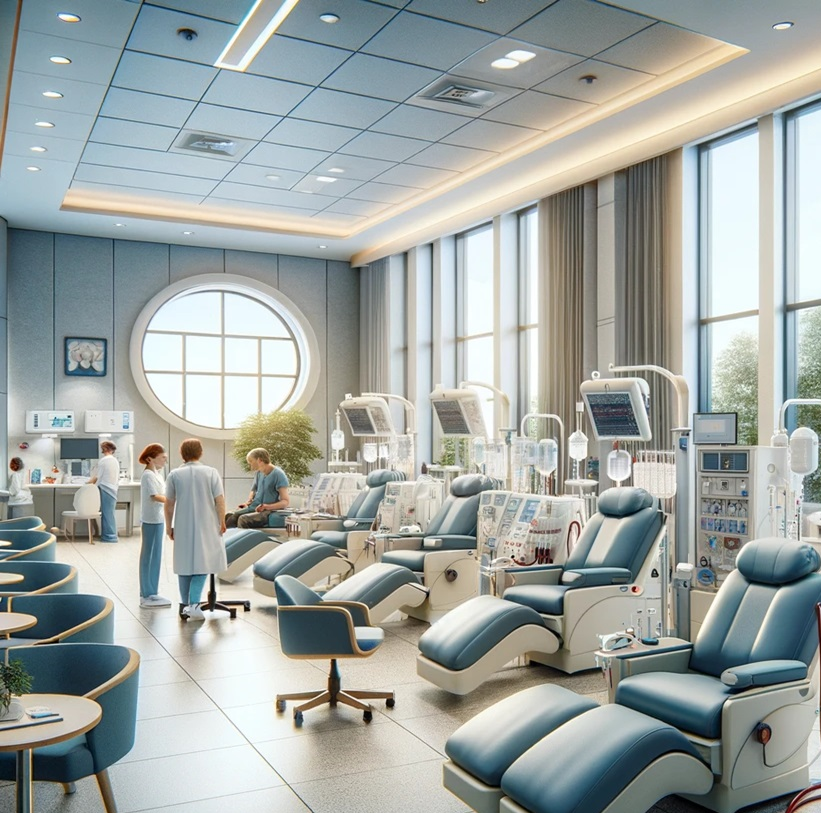
Dialysis centers are specialized medical facilities designed to provide life-sustaining treatment to patients with end-stage renal disease (ESRD) or severe chronic kidney disease (CKD). The primary function of these centers is to perform dialysis, a process that replicates the kidney’s function of filtering waste and excess fluids from the blood. This essay explores the essential equipment used in dialysis centers, highlighting their roles, functionalities, and importance in patient care.
Hemodialysis Machines
The cornerstone of any dialysis center is the hemodialysis machine. These machines are intricate systems that perform the vital task of cleaning the patient’s blood. Hemodialysis machines work by diverting blood from the patient’s body into a filter known as a dialyzer, where waste products and excess fluids are removed before the cleaned blood is returned to the body. The key components are:
Dialyzer: The dialyzer is a crucial component that consists of semi-permeable membranes. Blood flows on one side of the membrane while a dialysis solution flows on the other, allowing waste products to diffuse out of the blood and into the dialysis solution.
Blood Pump: This component moves blood from the patient’s body into the dialyzer at a controlled rate, ensuring efficient filtration.
Dialysate Delivery System: This system mixes and delivers the dialysis solution to the dialyzer. It carefully regulates the concentration of electrolytes and other substances in the solution to match the patient’s needs.
Monitors and Alarms: Hemodialysis machines are equipped with various sensors and alarms that monitor blood flow, pressure, and the efficiency of waste removal. These features ensure patient safety by alerting healthcare professionals to any irregularities during the treatment.
Water Treatment Systems
Dialysis requires a large volume of ultra-pure water to prepare the dialysate. Impurities in the water can lead to serious complications for patients; hence, dialysis centers use sophisticated water treatment systems to ensure the highest quality of water.
Main components include:
Reverse Osmosis (RO) Units: These units remove dissolved salts, bacteria, and other impurities from the water through a semi-permeable membrane.
Deionization Systems: Deionizers further purify water by removing ions, ensuring the water used in dialysis is free from any ionic contaminants.
Ultraviolet (UV) Sterilizers: UV light is used to sterilize water by destroying any remaining microorganisms, ensuring that the water is safe for dialysis.
Dialysis Chairs
Dialysis sessions typically last several hours, during which patients must remain in a fixed position. Therefore, dialysis chairs are designed for maximum comfort and functionality. These chairs are adjustable and equipped with features such as:
Reclining Functionality: Allows patients to recline at various angles for comfort.
Arm Supports: Essential for providing a stable area for needle insertion and blood flow monitoring.
Built-in Weight Scales: Some chairs come with integrated scales to monitor the patient’s weight before and after dialysis, helping to assess fluid removal.
Bloodline Systems
Bloodline systems are the sterile tubing and connectors used to transport blood from the patient to the dialyzer and back. They are critical for ensuring a closed and contamination-free circuit. Key components include:
Arterial Lines: Carry blood from the patient to the dialyzer.
Venous Lines: Return cleaned blood from the dialyzer to the patient.
Heparin Pumps: Administer anticoagulants to prevent blood clotting during the dialysis process.
Additional Equipment
Patient Monitoring Systems: Continuous monitoring of vital signs such as blood pressure, heart rate, and oxygen levels is crucial during dialysis to detect any adverse reactions promptly.
Backup Power Systems: Ensuring uninterrupted power supply is vital for dialysis centers to avoid treatment interruptions. Backup generators and uninterruptible power supplies (UPS) provide this security.
Disinfection and Sterilization Equipment: Autoclaves and other sterilization devices are used to disinfect reusable equipment, maintaining a sterile environment and preventing infections.
Conclusion
The effective operation of dialysis centers hinges on a wide array of specialized equipment, each playing a critical role in the delivery of safe and effective patient care. Hemodialysis machines, water treatment systems, dialysis chairs, bloodline systems, and patient monitoring equipment collectively ensure that patients receive the necessary treatment to manage their kidney disease.
Quiz
Please note that our articles are not intended to guide personal health decisions.
This content has been curated by Renes Care. Unauthorized use or reproduction is prohibited.
© Renes Care. All rights reserved.
